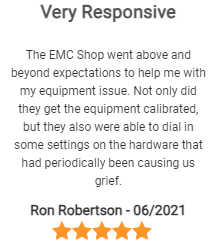START TESTING
Equipment & Materials
EMC Manufacturers
Shop by Brand
FCC Part 15
FCC EMC Testing Overview
FCC Part 15 regulates low power, unlicensed devices that could cause interference to the Amateur Radio Service and vice versa.
FCC EMC Testing is done at certified labs such as UL. Prior to investing the time and money to achieve certificiation, customers will setup and take measurements with mobile equipment to get an idea how their product performs against the emissions levels described in the standard.
FCC Part 15 covers an assortment of electronic equipment that generates RF energy whether it's intentional, unintentional or incidental. Amateurs will need to consider Part 15 as it relates to digital devices, computers, low-powered, unlicensed transmitters, electrical devices and any other "generic" device that might generate RF in the normal course of its operation.
DIY Before Going to the Lab
The EMC Shop is an ISO 17025 accredited company, stocking distributor and a preferred vendor in North America. Rental orders ship the same day, allowing customers to setup for precompliance radiated and conducted emissions measurements in accordance to FCC Part 15.
FCC Part 15 Test Setup
1. Preparation
- Ensure all equipment and instruments are calibrated and in working order.
- Set up the anechoic chamber or shielded room according to FCC guidelines.
- Place the Device Under Test (DUT) in the test environment.
2. Test Configuration
- Connect the DUT to the appropriate power source and any required peripherals.
- Configure the DUT according to its intended use and operating parameters.
- Set up the measurement equipment (spectrum analyzer, oscilloscope, etc.) for data collection.
3. Conducting the Test
- Start the emission test by transmitting signals at various frequencies and power levels.
- Measure and record emissions using the spectrum analyzer.
- Perform conducted emissions tests using appropriate probes and measurement techniques.
- Repeat the tests for different operating modes and conditions as required.
4. Data Analysis
- Analyze the recorded data to determine compliance with FCC Part 15 regulations.
- Identify any emissions exceeding permissible limits and their sources.
- Document all measurements and observations for inclusion in the test report.
5. Reporting
- Prepare a comprehensive test report detailing the test setup, procedure, results, and analysis.
- Include all relevant data, measurements, and observations, along with any deviations or issues encountered.
- Submit the test report to the appropriate regulatory authority for certification or approval.

